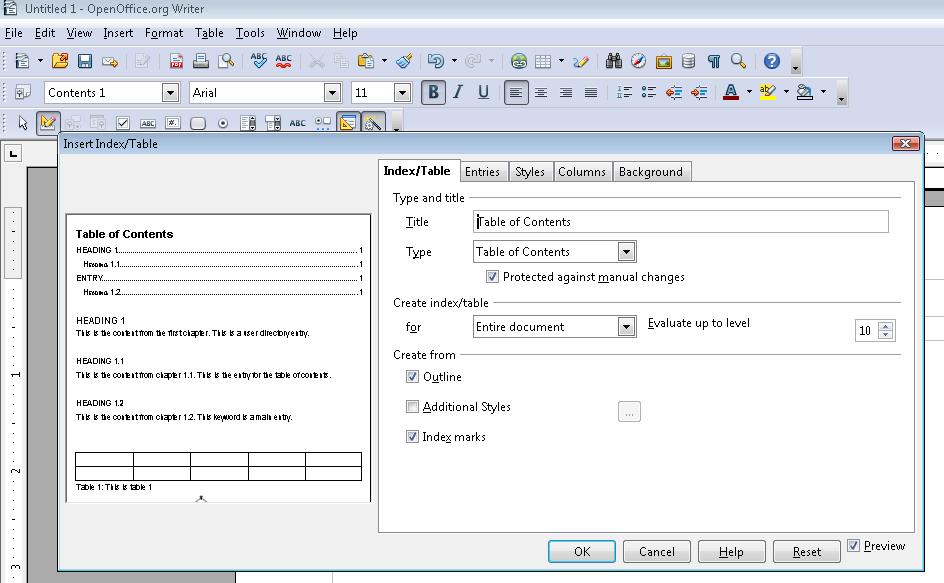
- #HOW TO CREATE A LINKED TABLE OF CONTENTS IN ADOBE PRO PDF#
- #HOW TO CREATE A LINKED TABLE OF CONTENTS IN ADOBE PRO FULL#
- #HOW TO CREATE A LINKED TABLE OF CONTENTS IN ADOBE PRO PORTABLE#
- #HOW TO CREATE A LINKED TABLE OF CONTENTS IN ADOBE PRO CODE#
- #HOW TO CREATE A LINKED TABLE OF CONTENTS IN ADOBE PRO LICENSE#
#HOW TO CREATE A LINKED TABLE OF CONTENTS IN ADOBE PRO PDF#
PDF (from version 1.4) supports transparent graphics PostScript does not.PDF contains tokenized and interpreted results of the PostScript source code, for direct correspondence between changes to items in the PDF page description and changes to the resulting page appearance.Īs a document format, PDF has several advantages over PostScript: Therefore, the entire PostScript world (fonts, layout, measurements) remains intact. Then, everything is compressed to a single file. Any files, graphics, or fonts to which the document refers also are collected.
#HOW TO CREATE A LINKED TABLE OF CONTENTS IN ADOBE PRO CODE#
The graphics commands that are output by the PostScript code are collected and tokenized. Historically, the PostScript-like PDF code is generated from a source PostScript file. PDF is largely based on PostScript but simplified to remove flow control features like these, while graphics commands equivalent to lineto remain.

It can handle graphics and standard features of programming languages such as if statements and loop commands. PostScript is a page description language run in an interpreter to generate an image, a process requiring many resources.

ISO 32000-2 does not include any proprietary technologies as normative references. In December 2020, the second edition of PDF 2.0, ISO 32000-2:2020, was published, including clarifications, corrections and critical updates to normative references. Many of them are also not supported by popular third-party implementations of PDF. These proprietary technologies are not standardized and their specification is published only on Adobe's website.
#HOW TO CREATE A LINKED TABLE OF CONTENTS IN ADOBE PRO FULL#
PDF 1.7, the sixth edition of the PDF specification that became ISO 32000-1, includes some proprietary technologies defined only by Adobe, such as Adobe XML Forms Architecture (XFA) and JavaScript extension for Acrobat, which are referenced by ISO 32000-1 as normative and indispensable for the full implementation of the ISO 32000-1 specification.
#HOW TO CREATE A LINKED TABLE OF CONTENTS IN ADOBE PRO LICENSE#
In 2008, Adobe published a Public Patent License to ISO 32000-1 granting royalty-free rights for all patents owned by Adobe that are necessary to make, use, sell, and distribute PDF-compliant implementations. PDF was a proprietary format controlled by Adobe until it was released as an open standard on July 1, 2008, and published by the International Organization for Standardization as ISO 32000-1:2008, at which time control of the specification passed to an ISO Committee of volunteer industry experts. In the early years PDF was popular mainly in desktop publishing workflows, and competed with a variety of formats such as DjVu, Envoy, Common Ground Digital Paper, Farallon Replica and even Adobe's own PostScript format. The PDF specification also provides for encryption and digital signatures, file attachments, and metadata to enable workflows requiring these features.Īdobe Systems made the PDF specification available free of charge in 1993.

PDF files may contain a variety of content besides flat text and graphics including logical structuring elements, interactive elements such as annotations and form-fields, layers, rich media (including video content), three-dimensional objects using U3D or PRC, and various other data formats. The last edition as ISO 32000-2:2020 was published in December 2020. PDF was standardized as ISO 32000 in 2008. PDF has its roots in "The Camelot Project" initiated by Adobe co-founder John Warnock in 1991. Based on the PostScript language, each PDF file encapsulates a complete description of a fixed-layout flat document, including the text, fonts, vector graphics, raster images and other information needed to display it.
#HOW TO CREATE A LINKED TABLE OF CONTENTS IN ADOBE PRO PORTABLE#
Portable Document Format ( PDF), standardized as ISO 32000, is a file format developed by Adobe in 1992 to present documents, including text formatting and images, in a manner independent of application software, hardware, and operating systems.


 0 kommentar(er)
0 kommentar(er)
